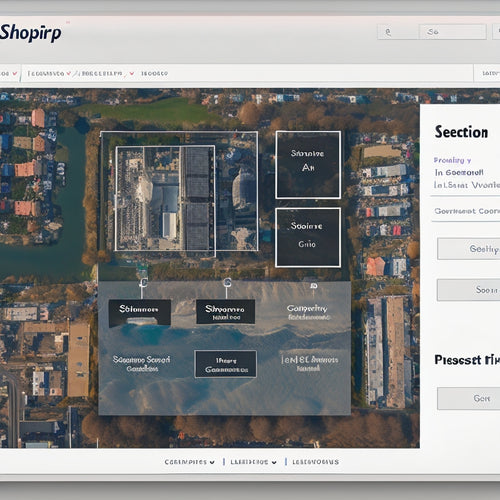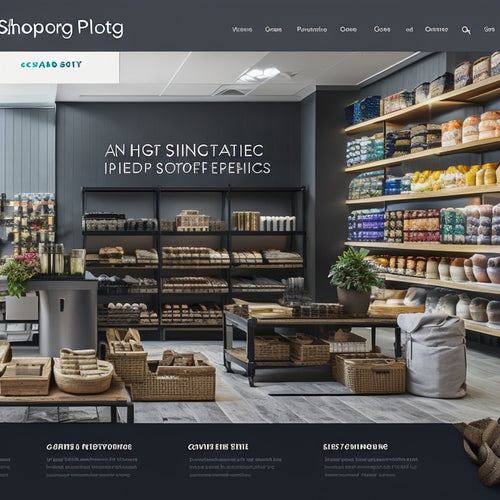
7 Best Online Course Strategies for Ecommerce Success
Share
You're about to reveal the seven most effective online course strategies that ecommerce entrepreneurs like you are using to drive sales, boost engagement, and build a loyal customer base. Start by establishing a strong online presence, creating engaging video lessons, and developing targeted sales funnels. Leverage user-generated content, maximize email marketing potential, and offer personalized learning paths to set yourself apart. Finally, utilize gamification strategies to drive engagement and motivation. By implementing these seven strategies, you'll be well on your way to ecommerce success. Now, let's dive deeper into each strategy to reveal their full potential.
Key Takeaways
• Develop targeted sales funnels to segment and optimize the customer journey, increasing conversion rates and ecommerce success.
• Leverage user-generated content to amplify social proof, boost community engagement, and foster brand loyalty, driving ecommerce growth.
• Implement personalized learning paths to tailor learning journeys for individual students, increasing engagement and success in ecommerce.
• Utilize gamification strategies to drive engagement, enhance motivation, and provide immediate feedback, leading to ecommerce success.
• Establish a strong online presence through high-quality content, showcasing expertise and building brand authority, crucial for ecommerce success.
Building Brand Authority Online
Establishing a strong online presence by creating high-quality, engaging content that resonates with your target audience and showcases your expertise, thereby setting you apart as a trusted authority in the ecommerce space. This is essential for building your online reputation and establishing authority in your niche.
You can further amplify your reach by partnering with influencers who share your values and target audience. These collaborations can help you tap into new markets and expand your online presence.
Additionally, consider brand collaborations that align with your goals and values. By doing so, you'll be able to leverage each other's expertise and audience, ultimately strengthening your online reputation and authority.
Creating Engaging Video Lessons
When creating video lessons for your ecommerce course, you're not just teaching a concept - you're holding your students' interest.
To do this, you'll need to craft engaging storylines that draw them in and keep them engaged.
Craft Compelling Storylines
By weaving a narrative thread throughout your video lessons, you'll captivate your audience and make complex ecommerce concepts more relatable and memorable. This is where storytelling techniques come into play. By incorporating a clear narrative structure, you'll create an emotional connection with your viewers, making them more invested in the learning process.
Here are some essential storytelling techniques to incorporate into your video lessons:
-
Create a relatable protagonist: Use a character that your audience can identify with, making the ecommerce concepts more tangible and accessible.
-
Use vivid descriptions: Paint a picture with words to help your audience visualize the concepts, making them more memorable and engaging.
-
Incorporate conflict and resolution: Create a sense of tension and resolution, making the learning process more engaging and satisfying.
-
Make it personal: Share personal anecdotes or experiences that illustrate the ecommerce concepts, adding a touch of authenticity and humanity.
-
Use metaphors and analogies: Help your audience understand complex concepts by relating them to familiar ideas or experiences.
Optimize Visual Elements
To craft video lessons that truly engage your ecommerce students, you'll need to balance informative content with visually appealing elements that reinforce your narrative and illustrate complex concepts. This is where optimizing visual elements comes in. You can't just throw some slides together and call it a day. Instead, you need to carefully consider the visual storytelling elements that will bring your lessons to life.
For instance, have you thought about the impact of color psychology on your students' emotional responses? Certain colors can evoke feelings of trust, excitement, or calmness, so choose your color scheme wisely. Additionally, use high-quality images, diagrams, and animations to break up text-heavy content and make complex concepts more digestible.
Don't be afraid to add some movement and interaction to your lessons, either. By incorporating these visual elements, you'll create an immersive learning experience that keeps your students engaged and motivated to succeed in the world of ecommerce.
Developing Targeted Sales Funnels
Crafting targeted sales funnels is crucial to maximizing conversions and profits in your ecommerce business, as it allows you to strategically guide potential customers through a personalized buying journey. By doing so, you'll be able to identify and cater to the specific needs of your ideal customer, increasing the likelihood of a sale.
To develop effective sales funnels, focus on the following strategies:
-
Segment your audience: Divide your customers into distinct groups based on their demographics, behaviors, and preferences. This will enable you to create targeted messaging and offers that resonate with each group.
-
Map the customer journey: Identify the touchpoints and pain points your customers experience as they move through the buying process. This will help you optimize each stage of the funnel for maximum conversions.
-
Optimize landing pages: Guarantee each landing page is tailored to the specific segment and stage of the funnel. Use clear, concise language and compelling visuals to drive conversions.
-
Streamline checkout processes: Make it simple for customers to complete their purchases by reducing friction and minimizing cart abandonment.
-
Continuously test and refine: Analyze funnel performance, identify areas for improvement, and make data-driven decisions to optimize conversion rates and boost profits.
Leveraging User-Generated Content
As you explore ways to leverage user-generated content, you'll want to contemplate how to incentivize customers to create content for you, amplify social proof to build credibility, and boost community engagement to foster a loyal customer base.
By doing so, you'll be able to tap into the powerful marketing potential of user-generated content.
Content Creation Incentives
Leveraging user-generated content can be a game-changer for your ecommerce brand, and incentivizing customers to create content can be a powerful way to encourage engagement and drive sales. By implementing content creation incentives, you can motivate your customers to share their experiences, opinions, and perspectives with others. This not only increases brand awareness but also builds trust and credibility.
Here are some effective content creation incentives you can use:
-
Reward systems: Offer discounts, freebies, or exclusive access to new products for customers who create and share content featuring your brand.
-
Content challenges: Launch a social media challenge that encourages customers to create and share content using a specific hashtag or theme.
-
Featured customer section: Create a dedicated section on your website or social media channels that showcases customer-generated content, giving creators a sense of pride and ownership.
-
Exclusive content opportunities: Offer customers early access to new products or services in exchange for creating content that showcases their experience.
-
Influencer partnerships: Collaborate with influencers who can encourage their followers to create content featuring your brand, and reward them with incentives such as commission or free products.
Social Proof Amplification
By showcasing user-generated content prominently on your website and social media channels, you're amplifying social proof and giving potential customers a reason to trust your brand. This trust building strategy is essential in ecommerce, where customers are more likely to buy from brands that have been vetted by others.
When you feature customer testimonials, reviews, and ratings, you're creating a sense of community and social validation that can't be replicated by traditional marketing tactics.
Influence marketing is another key benefit of social proof amplification. By partnering with influencers who've already built trust with their followers, you can tap into their audience and reach new customers. But it's not just about the influencer's content - it's about showcasing how their followers are using and loving your products.
This kind of user-generated content is incredibly powerful, as it provides social proof and credibility to potential customers. By amplifying this content, you'll not only drive sales but also build a loyal customer base that will advocate for your brand.
Community Engagement Boost
You can turbocharge your community engagement by showcasing the creative ways customers are using your products, turning them into brand ambassadors who drive conversations and inspire others to share their own experiences. By leveraging user-generated content, you'll not only build trust and credibility but also create a sense of belonging among your customers.
Here are some effective ways to boost community engagement:
-
Host virtual networking events and webinars to connect customers with similar interests
-
Create online forums for customers to share their experiences, ask questions, and provide feedback
-
Launch a social media campaign encouraging customers to share photos or videos of them using your products
-
Collaborate with influencers who can showcase your products in their own unique way
-
Develop a rewards program that incentivizes customers to share their stories and experiences with others
Maximizing Email Marketing Potential
About 72% of customers prefer to receive promotional emails from their favorite brands, making email marketing a significant channel for ecommerce businesses to nurture relationships and drive sales.
As you develop your online course strategy, optimizing your email marketing potential is crucial. You can achieve this by implementing email segmentation, which allows you to target specific groups of customers with tailored content. Automation also plays an important role in streamlining your email campaigns, saving you time and resources.
To enhance your email campaigns, you should also conduct A/B testing on subject lines to determine which ones resonate best with your audience. By doing so, you'll increase open rates and drive more conversions.
Remember, the secret to successful email marketing lies in personalization and relevance. By segmenting your audience and tailoring your content, you'll build stronger relationships with your customers and ultimately drive more sales.
Offering Personalized Learning Paths
Crafting tailored learning journeys allows your ecommerce students to navigate your online course at their own pace, focusing on the skills and knowledge they need to overcome specific pain points and achieve their business goals. This approach acknowledges that every student is unique, with different strengths, weaknesses, and learning styles. By offering tailored learning journeys, you can increase student engagement, motivation, and ultimately, their success.
To create effective tailored learning journeys, consider the following strategies:
-
Collect and analyze learner feedback to identify areas of improvement and adjust your course content accordingly
-
Use AI-powered tools to provide personalized recommendations for each student based on their progress, performance, and learning behavior
-
Develop multiple learning paths that cater to different learning styles, such as visual, auditory, or kinesthetic learners
-
Allow students to set their own goals and objectives, and provide them with a roadmap to achieve them
-
Continuously monitor student progress and adjust the learning journey as needed to ensure they stay on track
Utilizing Gamification Strategies
By incorporating game design elements into your ecommerce course, you can tap into students' natural competitive spirit and desire for achievement, driving engagement and motivation to new heights.
Gamification rewards, such as badges, points, or leaderboard rankings, can be used to incentivize students to complete interactive challenges and achieve course milestones. This approach not only boosts engagement levels but also enhances motivation techniques, encouraging students to take ownership of their learning journey.
To effectively utilize gamification strategies, identify key learning objectives and design challenges that align with these goals. For instance, create interactive quizzes, simulations, or scenario-based exercises that test students' understanding of ecommerce concepts.
Make sure to provide immediate feedback and recognition for their achievements, fuelling their desire to progress and improve. By leveraging gamification elements, you can create a more immersive and engaging learning experience, ultimately leading to higher course completion rates and better ecommerce outcomes.
Frequently Asked Questions
How Do I Ensure Students Complete My Entire Course?
To keep students engaged, you'll want to incorporate clever engagement techniques, like gamification and interactive quizzes, to boost motivation. Organize your course with a clear structure, and track progress to guarantee students stay on pace and complete your entire course.
Can I Reuse Content From My Blog or Website?
As you weave your online course tapestry, you're tempted to reuse threads from your blog or website; but beware, content repurposing raises SEO implications and plagiarism risks - guarantee originality shines through, don't duplicate, elevate.
What Is the Ideal Course Length for Ecommerce Success?
When structuring your online course, you're likely wondering what the ideal length is to keep students engaged. Aim for 30-60 minutes per module, with clear learning outcomes, to boost engagement strategies and student retention.
How Do I Handle Refunds and Customer Complaints?
When a storm of customer complaints brews, you're the captain of a ship that must navigate through treacherous waters. You'll keep your customers anchored with clear refund policies, swiftly resolving issues to guarantee customer satisfaction, and turning negative feedback into opportunities for growth.
Do I Need to Be a Subject Matter Expert to Create a Course?
You don't need to be a subject matter expert to create a course, but having some expertise helps with content creation. Focus on what you're passionate about, and design engaging content that drives student engagement and course completion.
Related Posts
-
Can Video Shopping Ads Be Used Effectively in Industries Outside of Fashion and Beauty?
Video shopping ads have become a popular marketing tool in the fashion and beauty industries, allowing consumers to ...
-

Adding Sitemap to Your Shopify Store: A Complete Guide
This article aims to provide a comprehensive guide on the process of adding a sitemap to a Shopify store. A sitemap ...
-

What Does It Take to Succeed in Shopify
Shopify, a popular e-commerce platform, offers numerous benefits and opportunities for success. This article aims to...

